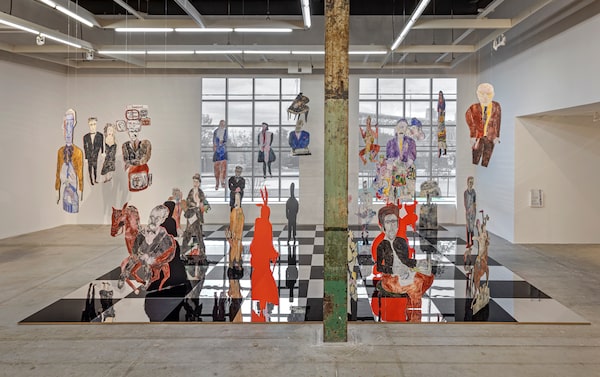Abdelkader Benchamma, Solastalgia: Archaeologies of Loss, at The Power Plant Contemporary Art Gallery, Toronto.TONI HAFKENSCHEID/Handout
The Fleck Clerestory at the Power Plant in Toronto is a lovely place to stand. There’s light and space above your head and a long corridor in front of you leading your eye to a view of the lake. It is also, however, a narrow corridor, not well configured for hanging art. Artists are regularly commissioned to create installations there and often seem to be left scratching their heads, defeated by the clerestory’s canyon-like walls.
Not Abdelkader Benchamma. This fall the French artist covered the two facing walls with a sweeping abstract mural in an almost monochromatic palette of black ink with touches of blue and brown. Its powerful horizontal lines look partly like a veined marble or wood grain and partly like a rushing river, making a virtue of the canyon effect: They create their own kind of cave, all the while drawing you outward to water.
Benchamma has titled the piece as above so below, a motto of Theosophists, occultists and New Agers that was taken from the medieval Arabic text The Emerald Tablet and refers to the correspondence between planes of existence. In a secular age, it’s interesting to compare his intervention in the clerestory to the aesthetic effect of church architecture: Without any particular religious reference, the artist has created a spiritual space.
Abdelkader Benchamma, Engramme - Souterrain, 2023. Ink on canvas.TONI HAFKENSCHEID/Handout
There is something yet larger at work in his impressive installations in the Power Plant’s east galleries, where his paintings are mounted as part of a mural that covers eight walls. Again, swaths of blue and black ink suggest both the microscopic and the macro, petrified wood, cracked stone, swirling ocean and rushing air. Water and wind seem to be dancing around the two rooms.
A human being is a small thing in comparison with geological time and environmental space, and the human presence here is very lightly inserted, as though to remind us of our insignificance: Benchamma has copied small prints of biblical scenes by the 19th-century French artist Gustave Doré, subtly altered them and inserted them into his paintings. On another wall, he has added a handful of old photographs, their faded surfaces dwarfed by the forms around them.
In a densely written text panel, curator Noor Alé describes the wide range of Benchamma’s references and interests: “… natural philosophy, geology, astronomy, alchemy, art history and existential literature.” Thankfully, you don’t need to grasp all those to appreciate the scope of the work.
Aria Dean, Abattoir, U.S.A.!, 2023.TONI HAFKENSCHEID/The Power Plant
Upstairs at the Power Plant, the American artist Aria Dean takes a very different approach to space in Abattoir, U.S.A.!, a brief, wordless film that travels through an empty slaughterhouse to a soaring score by composer Evan Zierk. Benchamma’s subject is vast; Dean’s is highly specific. The chilling place (partly created using 3-D modelling) is pristine and devoid of any human or animal. The photography is reminiscent of the late Lynne Cohen’s unsettling images of empty institutions, but Dean uses music brilliantly to insert an ironic romanticism: The metal hooks for hanging carcasses perform a danse macabre as the camera moves through them and the music rises. The viewer hardly needs to be reminded what goes on here: This is the architecture of death.
Dean is interested in modernism’s acquaintance with death, writes guest curator Julia Paoli of the Vega Foundation, a Canadian foundation that funds moving-image art. She makes the point that slaughterhouses were a product of 19th-century industrialization: The film sits well at the Power Plant, a 1926 heating and refrigeration plant that served the waterfront warehouses.
If Dean is specific about place, Anna Boghiguian is specific about time. Like Benchamma, she is interested in history, but the details as much as the sweep. The veteran Egyptian-Canadian artist is represented here by Time of Change, a mural of drawings that chart violent social change through history, including the French Revolution, the Russian Revolution and the horrors of the Holocaust – specifically the medical atrocities of the notorious Nazi doctor Aribert Heim. Boghiguian treats these difficult themes with an exuberance that belies their violence, her hard look at history colliding provocatively with her loose expressive style.

Anna Boghiguian, The Chess Game, 2022-23. Encaustic on Khadi paper, wood, acrylic panels and mirror-coated Plexiglas.TONI HAFKENSCHEID/The Power Plant Contemporary Art Gallery
Similarly Chess Game, a seemingly amusing installation of oversized chess pieces, considers the famous and the notorious. It was first commissioned for exhibitions in Italy and Austria, and the original figures are Europeans, especially Austrians, who changed history – whether they were queens or pawns. They include Marie Antoinette, Jean-Jacques Rousseau, Archduke Franz Ferdinand and Sigmund Freud. For the Power Plant, Boghiguian has added some Canadians, including Lester B. Pearson, Marshall McLuhan and Annie Pootoogook. Dressed in evening clothes, the figures of filmmaker Atom Egoyan and actor Arsinée Khanjian hover at the edge as through unsure what exactly this Viennese party is doing in Toronto.
Editor’s note: (Dec. 7, 2023): The Vega Foundation is a Canadian institution. Incorrect information appeared in an earlier version of this article.
To March 24 at the Power Plant in Toronto.
 Kate Taylor
Kate Taylor